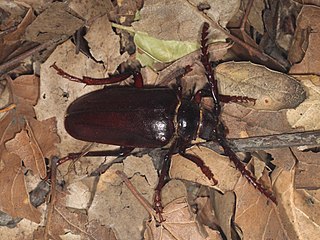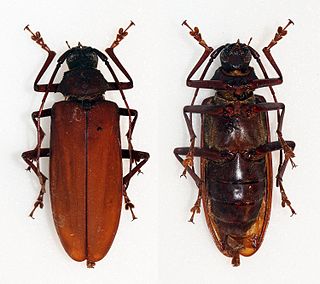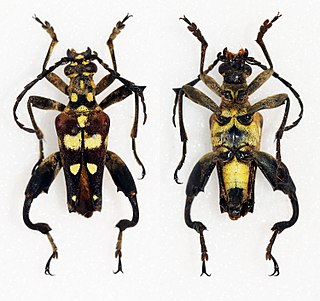
The longhorn beetles (Cerambycidae), also known as long-horned or longicorns, are a large family of beetles, with over 35,000 species described.

Prionus Geoffroy, 1762 is a genus of long-horned beetles of the subfamily Prioninae, tribe Prionini, widespread in Europe, Asia and North America.

The family Mycteridae is a small group of tenebrionoid beetles with no vernacular common name, though recent authors have coined the name palm and flower beetles. The family Mycteridae is distributed worldwide. There are about 30 genera and 160 species in three subfamilies Mycterinae, Hemipeplinae and Lacconotinae (=Eurypinae). These 3 subfamilies are extremely diverse in appearance and are sometimes difficult to have a present diagnosis of the adults at the family level. About 20 species are found in Australia, species of three genera are found in North America The larvae are generally flattened and typically inhabit the spaces between leaves or the bases of fronds, where they appear to consume fungi.

Lamiinae, commonly called flat-faced longhorns, are a subfamily of the longhorn beetle family (Cerambycidae). The subfamily includes over 750 genera, rivaled in diversity within the family only by the subfamily Cerambycinae.

Cerambycinae is a subfamily of the longhorn beetle family (Cerambycidae). The subfamily has a world-wide distribution including: Asia, Europe and the Americas. Within the family, the only subfamily of comparable diversity is the Lamiinae.

Dorcasominae is a subfamily in the longhorn beetle family Cerambycidae. There are about 14 genera and more than 30 described species in Dorcasominae, found mainly in Asia and Africa. These genera are sometimes considered members of the tribe Dorcasomini, which would be the only tribe of this subfamily. This classification is in accordance with the TITAN Cerambycidae database, Catalogue of Life, and Photographic Catalog of the Cerambycidae of the Old World. It is similar to that of Bouchard et al. in "Family-group names in Coleoptera", 2011.
Acutandra is a genus of Long-Horned Beetles in the beetle family Cerambycidae. There are more than 20 described species in Acutandra. They are found in Africa and the Neotropics

Birandra is a genus of Long-Horned Beetles in the beetle family Cerambycidae. There are about 14 described species in Birandra.

Parandra is a genus in the longhorn beetle family Cerambycidae. There are more than 20 described species in Parandra.

Strongylaspis is a genus of beetles in the longhorn beetle family, Cerambycidae.

Achrysonini is a tribe of Long-Horned Beetles in the beetle family Cerambycidae. There are more than 20 genera and 50 described species in Achrysonini. They are found mainly in the Americas, but also in Europe, Asia, and Africa.

Eburiini is a tribe of beetles in the subfamily Cerambycinae, synonymous with the tribe Heteropsini Lacordaire, 1868, containing the following genera:
Heteropsini is a tribe of beetles in the subfamily Cerambycinae, synonymous with the tribe Eburiini Blanchard, 1845, containing the following genera:
Oxylymma is a genus of beetles in the family Cerambycidae. The genus occurs in Central and South America, from Guatemala to Bolivia and Brazil.

Hamaederus pactor is a species in the longhorn beetle family Cerambycidae. It is found in Uruguay, Argentina, Bolivia, Brazil, and Paraguay.

Desmiphorini is a tribe of longhorn beetles of the subfamily Lamiinae.

Euporus is a genus of beetles belonging to the large subfamily Cerambycinae in the family of longhorn beetles (Cerambycidae).

The Apatophyseini are a tribe of longhorn beetles erected by Lacordaire in 1869. They are placed in the monotypic subfamily Apatophyseinae.

Hamaederus is a genus in the longhorn beetle family Cerambycidae. There are about 16 described species in Hamaederus, found in Mexico, Central America, and South America. Most of these species were formerly members of the genus Plocaederus.
Adlbauerandra is a genus of Long-Horned Beetles in the beetle family Cerambycidae. This genus has a single species, Adlbauerandra morettoi. It is found in Cameroon and the Central African Republic.

















